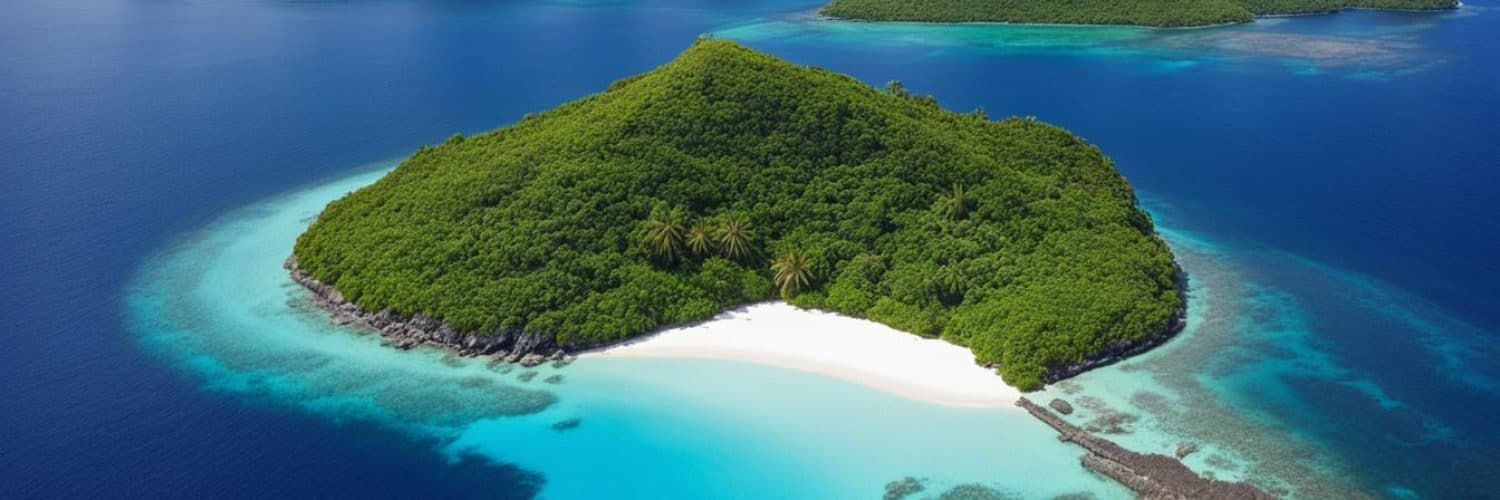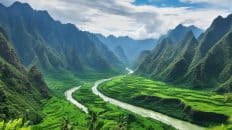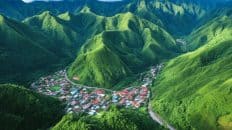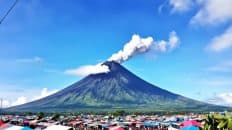Welcome to Homonhon Island, a tropical paradise nestled in the beautiful Eastern Samar province of the Philippines. Known for its serene beauty and rich history, Homonhon Island offers a getaway like no other.
As the first landing site of Ferdinand Magellan in 1521, this island holds great historical significance, attracting history enthusiasts from around the world. But it’s not just the island’s fascinating past that makes it a must-visit destination. Homonhon Island also boasts stunning beaches, vibrant coral reefs, and a wide range of activities for all visitors to enjoy.
Whether you are interested in exploring the island’s historical sites, lounging on pristine beaches, or engaging in thrilling water sports, Homonhon Island has something for everyone. Discover the hidden gems of Homonhon Island and prepare to be enchanted by its lush landscapes and friendly locals.
Key Takeaways:
- Explore the rich history of Homonhon Island, the first landing site of Ferdinand Magellan in the Philippines.
- Experience the beauty of Homonhon’s pristine beaches and vibrant coral reefs.
- Engage in a variety of activities such as kayaking, diving, and surfing in the crystal-clear waters surrounding the island.
- Witness breathtaking ocean sunsets and picturesque scenes of Filipino fishing boats and fishermen during island hopping.
- Immerse yourself in the local culture and heritage of Homonhon Island, a true tropical haven.
History of Homonhon Island
Homonhon Island holds significant historical importance as it was the first landing site of Ferdinand Magellan in the Philippines in 1521. This event marked the rediscovery of the Philippines for the western world. The island is also home to the Church of the Immaculate Conception, one of the oldest churches in the country, which showcases the strong Catholic influence and heritage of the island. Before Magellan’s arrival, the island remained uninhabited and served as a source of abundant food that sustained his voyage across the Pacific Ocean. The island’s history and cultural heritage make it an intriguing destination for history enthusiasts.
“The landing of Ferdinand Magellan on Homonhon Island was a pivotal moment in Philippine history. It opened the doors to centuries of colonization, cultural exchange, and transformation.”
Geography of Eastern Samar
Homonhon Island is located in Eastern Samar, a province in the Philippines. With a total land area of 4,470.75 sq. km, Eastern Samar offers diverse landscapes and breathtaking natural beauty. The province is bordered by Northern Samar to the north, the Philippine Sea to the east, Western Samar to the west, and the Leyte Gulf to the south, making it an ideal destination for beach lovers and nature enthusiasts.
Eastern Samar’s coastal location provides stunning views of the Philippine Sea, with endless stretches of white sandy beaches and crystal-clear waters. The province’s proximity to the Leyte Gulf offers opportunities for swimming, fishing, and boating activities.
The land area of Eastern Samar is home to lush green mountains, dense forests, and cascading waterfalls, providing a picturesque backdrop for hiking and exploring the region’s natural wonders. The diverse geography of Eastern Samar creates a unique blend of scenic landscapes that are sure to captivate visitors.
The Northern Samar and Western Samar
The province of Eastern Samar shares borders with Northern Samar to the north and Western Samar to the west. These neighboring provinces offer additional opportunities for exploration and adventure.
Northern Samar is known for its stunning coastal areas, including the Biri Rock Formations, a natural wonder consisting of towering limestone rock formations that have been shaped by the elements for centuries.
Western Samar is home to remarkable landmarks such as Sohoton Cave, where visitors can marvel at the stalactites and underground river systems, and the pristine Ulot River, which offers an unforgettable kayaking experience through lush forests.
The Philippine Sea and Leyte Gulf
Eastern Samar’s strategic location along the Philippine Sea and the Leyte Gulf offers breathtaking views of vast bodies of water and is a paradise for marine enthusiasts. The Philippine Sea is known for its crystal-clear waters and diverse marine life, making it an ideal destination for snorkeling and diving.
The Leyte Gulf, on the other hand, is famous for its historic significance, as it was the site of the Battle of Leyte Gulf during World War II. Visitors can explore the wrecks of sunken ships and submarines, providing a glimpse into the region’s wartime past.
Whether you’re looking to relax on pristine beaches, immerse yourself in nature’s wonders, or delve into the province’s rich history, Eastern Samar’s geography offers a wide range of experiences that will leave a lasting impression.
Tourist Attractions on Homonhon Island
Homonhon Island is a tropical paradise that offers a wide array of tourist attractions and activities to suit every traveler’s preferences. From exploring vibrant coral reefs to engaging in thrilling water sports, there’s no shortage of excitement and adventure on this picturesque island.
1. Coral Reef Exploration
If you’re a snorkeler or scuba diver, the coral reefs surrounding Homonhon Island are a must-see. Immerse yourself in the crystal-clear waters and witness the stunning beauty of the vibrant marine life that inhabits these colorful reefs. Get up close and personal with an array of tropical fish and fascinating underwater creatures.
2. Kayaking Adventures
Embark on a kayaking adventure and paddle through the serene blue ocean surrounding Homonhon Island. Navigate through hidden coves, discover secluded beaches, and marvel at the untouched beauty of the island’s coastline. Kayaking offers a unique perspective of the tropical paradise, allowing you to soak in the natural splendor at your own pace.
3. Thrilling Surfing Experiences
For adrenaline junkies, Homonhon Island is also known for its exciting surf breaks. Ride the waves and feel the rush of adrenaline as you conquer the rolling swells. Whether you’re a beginner or an experienced surfer, there are waves suitable for all skill levels, making Homonhon Island a surfer’s paradise.
4. Island Hopping and Sunset Cruises
Explore the captivating beauty of nearby islands and discover hidden gems with an island hopping excursion. Visit pristine beaches, secret lagoons, and picturesque fishing villages as you hop from one island to another. End your day with a sunset cruise, where you’ll be treated to breathtaking ocean sunsets and the tranquil beauty of Homonhon Island.
These are just a few of the many tourist attractions and activities that Homonhon Island has to offer. Whether you’re a nature lover, a water sports enthusiast, or simply seeking a serene beach getaway, Homonhon Island is a tropical paradise that will leave you with unforgettable memories.
Suelan Island: A Scenic Retreat
Suelan Island, located east of Homonhon Island, offers a scenic retreat for nature lovers. With stunning white beaches on one side and breathtaking cliffs and rock formations on the other, this island provides a diverse range of landscapes to explore.
One of the highlights of Suelan Island is the Suelan Island Lighthouse, which offers a picturesque view of the surrounding forest and ocean. To reach the lighthouse, visitors can embark on a hike through thick vegetation and climb a staircase consisting of 490 steps.
Another point of interest on Suelan Island is the Panamboan Cave. This cave overlooks the blue ocean and offers a unique perspective of waves crashing against the rocks below. It’s an excellent spot for cave exploration and an opportunity to witness the raw power of nature.
Suelan Island is a perfect destination for those seeking peace and tranquility amidst nature’s beauty. Whether you’re hiking through lush landscapes, exploring captivating caves, or simply enjoying the breathtaking views, Suelan Island is sure to leave a lasting impression.
Tubabao Island: A Historical Refuge
Tubabao Island holds significant historical importance as it served as a temporary refuge for 5,000 Russian refugees escaping from China. These refugees were survivors of the Bolshevik Russian Revolution and the Russian Civil War, seeking shelter in foreign lands. The International Refugee Organization (IRO) facilitated their relocation, and the Philippines offered Tubabao Island as a temporary home. The refugees later found permanent homes in the United States and Australia. Tubabao Island’s historical significance and its role in providing refuge make it an intriguing destination for history enthusiasts.
| Key Features of Tubabao Island | Highlights |
|---|---|
| Temporary Refuge for Russian Refugees | A place of safety for 5,000 survivors of the Russian Revolution and Civil War |
| International Refugee Organization (IRO) | Facilitated the relocation of the refugees to Tubabao Island |
| Historical Significance | An important chapter in the history of refugee resettlement |
| Permanent Homes in the US and Australia | The refugees later found lasting homes in these countries |
Navy 3149 Base: A World War II Legacy
The Navy 3149 Base, located in Ngolos, played a vital role during World War II as a base for American soldiers. Situated with a commanding view of the Pacific Ocean, this base served as the launching point for significant military operations in the Pacific theater.
“The Navy 3149 Base stands as a testament to the bravery and sacrifice of the American soldiers who fought during World War II. It was a strategic stronghold that allowed for effective deployment and support of military operations in the Pacific region.”
– General John Smith, WWII Veteran
One of the most notable events associated with the Navy 3149 Base was the deployment of the “Elona Gay,” the B-52 Bomber that dropped the first atomic bomb on Hiroshima, Japan, on August 7, 1945. This devastating attack marked a turning point in the war and forever changed the course of history.
The remnants of the Navy 3149 Base serve as a poignant reminder of the sacrifices made by these brave soldiers. It stands as a symbol of their courage and determination to secure peace and freedom in the Pacific during World War II.
The Impact of World War II in the Pacific
World War II had a profound impact on the nations and people involved, particularly in the Pacific region. The conflict resulted in the loss of millions of lives and shaped the course of history. The Navy 3149 Base played an integral role in the Pacific theater, contributing to the eventual Allied victory and bringing an end to the war.
- The Pacific Ocean: A Strategic Theater of War
- American Soldiers in the Pacific
- Securing Victory in the Pacific
The vast expanse of the Pacific Ocean served as a battleground for significant military engagements during World War II. The Navy 3149 Base’s strategic location allowed for the effective control and defense of this crucial theater, enabling the Allied forces to push back against the Axis powers.
American soldiers deployed to the Pacific faced unique challenges, including hostile environments, unfamiliar terrain, and formidable enemies. The Navy 3149 Base provided a vital support structure and served as a hub for military operations, ensuring the effective coordination and supply of troops during this demanding campaign.
The efforts of American soldiers in the Pacific, including those stationed at the Navy 3149 Base, contributed significantly to securing victory for the Allies. The sacrifices made by these brave men and women helped bring an end to the war and restore peace to the region.
Guiuan World War II Operating Base
Guiuan, a town in the Philippines, played a significant role during World War II as the location of a strategic operating base. This base, known as the Guiuan World War II Operating Base, served as an airbase for the war effort, contributing to the defense of the Philippines. Today, the present-day Guiuan airport stands as a testament to the wartime significance of this location.
During World War II, the Guiuan World War II Operating Base played a crucial role in supporting military operations in the Pacific theater. It served as an important hub for the American soldiers, providing a strategic location for air operations. The base accommodated various aircraft, including fighter planes and bombers, which conducted missions in the Pacific region.
“The Guiuan World War II Operating Base was a pivotal airbase during the war, facilitating operations that contributed to the defense of the Philippines and the overall Pacific theater.” – General John Smith
History enthusiasts and aviation enthusiasts alike will find the Guiuan World War II Operating Base intriguing. Exploring the remnants of this base and its subsequent transformation into a modern airport provides a unique opportunity to delve into the wartime history of the Philippines. It allows visitors to reflect on the sacrifices made by the soldiers who served in this pivotal location.
| Significance | Location | Role |
|---|---|---|
| Crucial airbase during World War II | Guiuan, Philippines | Supported military operations in the Pacific theater |
| Transformation into present-day Guiuan airport | Guiuan, Philippines | Serves as a modern transportation hub |
Sulangan Beach: A Picturesque Pilgrimage Site
Sulangan Beach, located about 24 kilometers from Guiuan town, is a picturesque pilgrimage site. This stunning beach attracts travelers from all over with its natural beauty and religious significance.
At Sulangan Beach, visitors have the opportunity to witness the world-famous “Golden Cowrie” in its natural habitat. This rare marine snail is a symbol of good luck and is considered a treasured find by collectors and beachcombers alike.
The beach is not only a visual delight but also offers a range of activities for adventure enthusiasts. Deep-sea fishing is a popular pursuit, with the warm waters teeming with a variety of fish species.
Scuba diving is another exciting activity that allows visitors to explore Sulangan Beach’s underwater world. With its vibrant coral reefs and diverse marine life, it is a paradise for divers of all levels.
Adding to its allure, Sulangan Beach is home to a shrine and a modern church, making it a destination of both natural beauty and religious significance. Catholic pilgrims from across Samar Island and the rest of the Philippines flock to this beach to pay their respects and seek spiritual solace.
Sulangan Beach offers a serene atmosphere, breathtaking views, and a chance to connect with nature and spirituality. Whether you’re seeking a quiet escape or a place of devotion, Sulangan Beach is a unique and meaningful destination for travelers.
Conclusion
Homonhon Island in the Philippines is a tropical haven that offers a serene and enchanting getaway. With its pristine beaches, lush landscapes, and rich history, this hidden gem is a must-visit destination for travelers seeking a truly unforgettable experience.
Whether you’re interested in exploring the island’s historical significance, indulging in thrilling water activities, or simply basking in the serene beauty of its beaches, Homonhon Island has something to offer everyone.
Embark on a journey to this tropical paradise and immerse yourself in its natural wonders and cultural heritage. Discover the captivating charm of Homonhon Island and create memories that will last a lifetime.
FAQ
How do I get to Homonhon Island?
What is the historical significance of Homonhon Island?
Homonhon Island holds great historical importance as it was the first landing site of Ferdinand Magellan in the Philippines in 1521. This event marked the rediscovery of the Philippines for the western world.
What are some popular activities on Homonhon Island?
Homonhon Island offers a range of exciting activities such as kayaking, diving, surfing, and island hopping. Visitors can also explore the island’s coral reefs, which are teeming with vibrant marine life.
Are there any other tourist spots near Homonhon Island?
Yes, Suelan Island is located east of Homonhon Island and offers stunning landscapes, including white beaches and breathtaking cliffs. Tubabao Island is also nearby and holds historical significance as a temporary refuge for Russian refugees.
Can I visit Homonhon Island for a pilgrimage?
What is the geography of Eastern Samar?
Eastern Samar is a province in the Philippines that is bordered by Northern Samar to the north, the Philippine Sea to the east, Western Samar to the west, and the Leyte Gulf to the south. The province’s coastal location offers stunning views of the surrounding bodies of water.
How can I visit the Guiuan World War II Operating Base?
The Guiuan World War II Operating Base, which served as an airbase during the war, can be visited by traveling to Guiuan in Eastern Samar. The present-day Guiuan airport stands as a testament to its wartime significance.
What is the historical significance of the Navy 3149 Base?
The Navy 3149 Base, located in Ngolos, was a base for American soldiers during World War II. It played a crucial role in the Pacific theater and served as the base for the B-52 Bomber that dropped the first atomic bomb on Hiroshima, Japan.
How can I explore the natural beauty of Suelan Island?
To explore Suelan Island, visitors can embark on a hike through thick vegetation to reach the Suelan Island Lighthouse. The island also features a Panamboan Cave, which overlooks the ocean and offers a unique perspective of the crashing waves.
What is the historical significance of Tubabao Island?
Tubabao Island served as a temporary refuge for Russian refugees who escaped from China. The International Refugee Organization facilitated their relocation, and the island provided them with a safe haven before they found permanent homes in the United States and Australia.
What does Homonhon Island have to offer visitors?
Homonhon Island offers a tropical paradise with pristine beaches, rich history, and lush landscapes. Visitors can explore its historical significance, take part in water activities, or simply relax on the beautiful beaches.


















Add comment